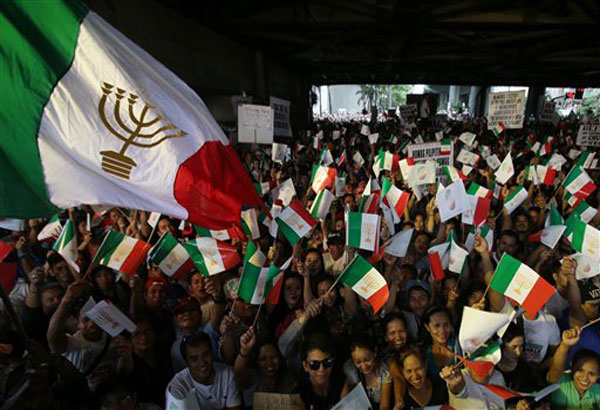Mindanao war to cost P100 B the next 10 years — WB study
April 24, 2002 | 12:00am
DAVAO CITY — The recurring conflict affecting Mindanao could cost over P100 billion in the next 10 years, particularly for the southwestern parts of the island.
The amount was pegged in a preliminary finding of an ongoing investigative study conducted by the World Bank on the economic costs of the conflict in Mindanao.
The same study, likewise, proved that when the intensity level of the conflict in Mindanao is high, the gross regional domestic product (GRDP) of the island is also at its lowest. And when there is relative peace in Mindanao, there is also a surge in its economic performance.
Presidential Assistant on Regional Development Paul Dominguez said the study is still incomplete and would be finished within the next two to three months.
He presented portions of the findings of the WB study during last weekend’s roundtable conference initiated by Kusog Mindanaw group on the costs of Mindanao conflict held here at the Marco Polo Hotel.
"It was noted that the times when there was an absence of war or even tension in Mindanao were also the times that economic activities flourished in the island as reflected in its GRDP," Dominguez said.
The WB study also stated that the present value of the economic cost of recurring conflict in Southwestern Mindanao alone, where the conflict is most felt, would be at least $2 billion or P100 billion over the next 10 years.
"If we don’t address the recurring conflict, it will cost us at least P100 billion over the next 10 years in Southwestern Mindanao alone. Non-investment in Southwestern Mindanao will result in more social unrest and greater problems in Mindanao," Dominguez warned.
He pointed out that the WB study does not include the social and other inherent costs the conflict has brought to Mindanao, which supposedly is the country’s richest area in natural and agricultural resources.
"The social cost is something that is not quantifiable and which, we know, took a heavy toll on Mindanaoans," Dominguez said.
The WB study factored in the population profile of Mindanao in relation to the recurring conflict. From a largely Muslim-dominated island, particularly 25 years following the Independence in 1946, other Filipino migrants started to flock to Mindanao, displacing Muslims and the Lumads who were forced to move to the southwestern area of the island.
In 1903, Mindanao’s Muslim population was 76 percent compared to the non-Muslim at only 24 percent. Ten years later, the equation changed to 63 percent Muslim against the 37 percent non-Muslim. And in 1918, it was already a 50 percent breakdown between the two groups.
At present, the Muslims have become a minority of only about four million as against the non-Muslims of over 16 million.
The Mindanao conflict, the study observed, has largely been concentrated in the southwestern parts that include Regions IX, XII and the Autonomous Region for Muslim Mindanao (ARMM). These are the same areas that the MNLF, MILF and the Abu Sayyaf have claimed to be their strongholds and where they have had clashes with government forces.
The conflict also impacted on the agriculture production of Southwestern Mindanao which registered a constant low level and did not experience any growth from 1970 to the 1990s.
From 1970 to 1982, the conflict had cost Southwestern Mindanao an average of one percent of its per capita GDP. The figures again plummeted between 1997 and 2001 with the conflict costing an average of 0.5 percent of the area’s GDP.
The amount was pegged in a preliminary finding of an ongoing investigative study conducted by the World Bank on the economic costs of the conflict in Mindanao.
The same study, likewise, proved that when the intensity level of the conflict in Mindanao is high, the gross regional domestic product (GRDP) of the island is also at its lowest. And when there is relative peace in Mindanao, there is also a surge in its economic performance.
Presidential Assistant on Regional Development Paul Dominguez said the study is still incomplete and would be finished within the next two to three months.
He presented portions of the findings of the WB study during last weekend’s roundtable conference initiated by Kusog Mindanaw group on the costs of Mindanao conflict held here at the Marco Polo Hotel.
"It was noted that the times when there was an absence of war or even tension in Mindanao were also the times that economic activities flourished in the island as reflected in its GRDP," Dominguez said.
The WB study also stated that the present value of the economic cost of recurring conflict in Southwestern Mindanao alone, where the conflict is most felt, would be at least $2 billion or P100 billion over the next 10 years.
"If we don’t address the recurring conflict, it will cost us at least P100 billion over the next 10 years in Southwestern Mindanao alone. Non-investment in Southwestern Mindanao will result in more social unrest and greater problems in Mindanao," Dominguez warned.
He pointed out that the WB study does not include the social and other inherent costs the conflict has brought to Mindanao, which supposedly is the country’s richest area in natural and agricultural resources.
"The social cost is something that is not quantifiable and which, we know, took a heavy toll on Mindanaoans," Dominguez said.
The WB study factored in the population profile of Mindanao in relation to the recurring conflict. From a largely Muslim-dominated island, particularly 25 years following the Independence in 1946, other Filipino migrants started to flock to Mindanao, displacing Muslims and the Lumads who were forced to move to the southwestern area of the island.
In 1903, Mindanao’s Muslim population was 76 percent compared to the non-Muslim at only 24 percent. Ten years later, the equation changed to 63 percent Muslim against the 37 percent non-Muslim. And in 1918, it was already a 50 percent breakdown between the two groups.
At present, the Muslims have become a minority of only about four million as against the non-Muslims of over 16 million.
The Mindanao conflict, the study observed, has largely been concentrated in the southwestern parts that include Regions IX, XII and the Autonomous Region for Muslim Mindanao (ARMM). These are the same areas that the MNLF, MILF and the Abu Sayyaf have claimed to be their strongholds and where they have had clashes with government forces.
The conflict also impacted on the agriculture production of Southwestern Mindanao which registered a constant low level and did not experience any growth from 1970 to the 1990s.
From 1970 to 1982, the conflict had cost Southwestern Mindanao an average of one percent of its per capita GDP. The figures again plummeted between 1997 and 2001 with the conflict costing an average of 0.5 percent of the area’s GDP.
BrandSpace Articles
<
>
- Latest
- Trending
Trending
Latest
Trending
Latest
Recommended

































